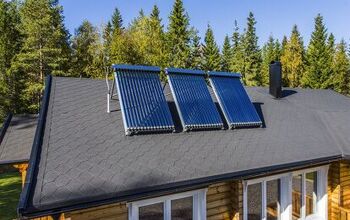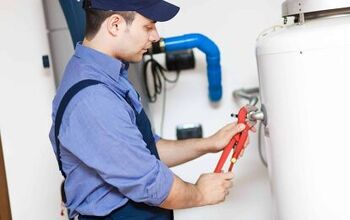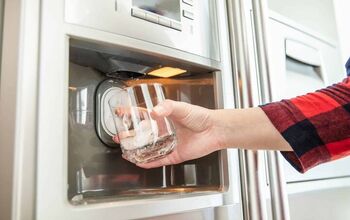Upflow Vs. Downflow Water Softener: Which One Is Better?

Hard water can wreak havoc on your plumbing, leave residue on your dishes, and cause other issues in your home. When you’re looking to purchase a water softener to solve these problems, you’ll notice that there are two main types. But what is the difference between upflow and downflow water softeners, and which is the best?
While upflow and downflow water softeners both soften water by use of a filter, upflow water softeners provide more efficiency. Upflow water softeners are more environmentally friendly, less wasteful, and more affordable to run. The regeneration process for upflow softeners allows them to use 30% less salt, which in turn eliminates the need for a dual tank system in your home.
Need a Water Treatment and Purification System Installed or Replaced?
Get free, zero-commitment quotes from pro contractors near you.

How Does An Upflow Water Softener Work?
Just as its name suggests, an upflow water softener directs water from the bottom up. First, the water enters the tank and flows through an upper basket. Then, the water moves through a riser tube and is distributed through another basket.
At this point, the water flows through the filter media in a swirling motion. The filter is meant to remove minerals, such as calcium and magnesium, and replace them with salt. This process softens the water so it doesn’t leave behind mineral deposits that can clog plumbing and cause other issues.
Pros of Upflow Water Softeners
One of the best benefits of choosing an upflow water softener is that it will save you salt, water, and money. Upflow water softeners are extremely efficient and have an increased capacity of about 10%.
No Backwashing Necessary
Upflow water softeners typically don’t require backwashing. This is because the filter media is fluffed every time water flows through the tank, keeping it from becoming compacted. Channeling, when water creates tunnels or channels in the filter media, is not a problem with upflow water softeners.
Higher Salt Conversion
Another advantage of upflow water softeners is that they force the filter media to swirl. This results in a longer contact time for the filter media and the untreated water.
A longer contact time means higher salt conversion, less ion leakage, and decreased fluoride discharge. In fact, upflow water softeners have about 1/10th of the amount of leakages that downflow water softeners do.
Reduction In Brine Usage
Upflow water softeners (compared to downflow water softeners) have a 15-30% reduction in the amount of brine used for regeneration.
Low Electric Cost
A final benefit of upflow models is that most upflow water softeners do not require the use of electricity. Therefore, they won’t cause your electric bill to increase. In addition, most upflow water softeners don’t use drain lines.
Cons of Upflow Water Softeners
There are only a couple of downsides to upflow water softeners. They take longer to regenerate because the untreated water and filter media have a longer contact time.
Complexity
In addition, upflow water softeners are more complex than downflow water softeners. There is much more liquid engineering required to make the water flow upward.
Next, we’ll discuss downflow water softeners…
How Does A Downflow Water Softener Work?
In a downflow water softener, water enters from the top and flows downward. Water first flows into the upper basket and moves down the tank. It then flows through the filter around the outside of the distributor tube.
Next, the water makes its way into the lower basket, up the riser tube, and out of the tank. Just like the upflow water softener, this process is meant to soften hard water. Minerals are removed and replaced with salt as the water passes through the filter.
Pros of Downflow Water Softeners
A positive aspect of downflow water softeners is that they’re much simpler than upflow water softeners. They require less configuration and tend to be easier to understand.
Necessary In Some Cases
In certain cases, like the removal of iron from water using oxidation media, a downflow system may be necessary. If you need to flush out oxidized iron, it may be best to use a downflow system.
Less Likely to Become Plugged
Finally, the injector nozzle on a downflow water softener is larger than that of an upflow water softener. This means that it is less likely to become plugged as quickly as an upflow water softener might.
Cons of Downflow Water Softeners
Unfortunately, there are quite a few downsides to downflow water softeners. While they were once the norm, they’re now considered wasteful and inefficient. Downflow water softeners use more water and more salt, and they cost more to run and maintain.
Not Environmentally Friendly
A notable drawback to downflow water softeners is that they produce quite a bit of leakage. Nearly half of the salt used ends up going down the drain. This results in large amounts of chloride discharge, which can have negative effects on the environment.
Backwashing Required
Another downfall of downflow water softeners is that the resin material or filter media quickly becomes compacted. This is because the constant downward flow of water causes the material to condense.
For this reason, backwashing is required with downflow water softeners. Even with backwashing, there’s still a risk of channeling. This is when water creates tunnels in the filter media and weakens the effectiveness of the filter.
Upflow vs. Downflow Water Softener: Evaluation Criteria
Here we’ll compare upflow and downflow water softeners in a few different areas. This should give you a better idea of their similarities and differences.
Cost
Upflow water softeners vary in price from $700 to $2000. The initial cost is more expensive than downflow water softeners, but upflow water softeners are cheaper to maintain. In the long run, upflow water softeners provide better value.
Downflow water softeners can range from $600 to over $1500. Aside from the product itself and installation costs, you’ll also spend more on water and salt. In addition, your energy costs are likely to be higher when using a downflow water softener.
Longevity
Both upflow and downflow water softeners can last for 10 to 15 years. However, it’s very important to maintain your water softener properly to maximize its lifespan.
Method of Softening Water
Upflow and downflow water softeners both use filters to replace minerals in the untreated water with salt. The bottom-to-top flow of water employed by upflow water softeners is more complex and requires more liquid engineering. This results in increased contact time for the water and the filter.
With upflow water softeners, the filter has no risk of becoming compacted. In contrast, downflow water softeners are simpler and don’t need as much configuration. Still, the downward motion of the water can quickly begin to compact the filter media.
Need a Water Treatment and Purification System Installed or Replaced?
Get free, zero-commitment quotes from pro contractors near you.

Related Questions
Is a water softener necessary?
Overall, a water softener is not required. It is more of a matter of personal preference. However, there are several signs that you might benefit from having a water softener installed.
For example, hard water can cause mineral deposit buildup on the inside of your plumbing, decreasing water flow. Limescale deposits can also build up on your dishes and cutlery, leaving behind a chalky, hard-to-clean film.
If you have hard water, you may also notice stains on your bathroom fixtures, as well as dry hair and itchy skin. Faded clothing, high utility bills, and a damaged water heater can also result from hard water.
If you’ve experienced any of these issues, it’s likely that a water softener would make a positive difference in your home.
What does a water softener do?
A water softener, sometimes called an ion exchange unit, is an appliance that removes minerals from water. The filter inside of the water softener exchanges minerals like calcium and magnesium for salt.
Hard water, or water with minerals, can cause many problems like clogged plumbing and a chalky film on your dishes. It can even make your hair dry and your skin itchy. Using a water softener prevents these problems by softening the water.
What does regenerate mean on a water softener?
Regeneration is when a water softener flushes out the minerals it filtered out of the hard water. This process allows water softeners to continue softening new water as it moves through them.
Regeneration is necessary with downflow water softeners to avoid channeling. This is when the filter’s effectiveness is reduced due to tunnels being created in the filter media. However, channeling isn’t an issue with upflow water softeners, and so regeneration usually isn’t needed.
Upflow vs. Downflow Water Softener: The Final Verdict
When choosing between upflow and downflow water softeners, there’s an obvious choice. Upflow water softeners come with many more benefits, not the least of which is decreased cost. Upflow water softeners use less water and salt, and they’re much more efficient than downflow water softeners.
In addition, upflow water softeners are more environmentally friendly, while downflow water softeners come with lots of chloride discharge. Plus, backwashing isn’t necessary with upflow water softeners. Finally, channeling isn’t an issue because the water flows upward, constantly fluffing the filter media.
There may be some situations in which a downflow water softener is a better choice. But overall, upflow water softeners provide the most value and effectiveness.

With a lifelong passion for writing plus strong enthusiasm for home improvement and DIY projects, joining the team at Upgraded Home was an easy choice. Jessica Allen likes to share helpful information with current and aspiring homeowners. Aside from writing, Jessica loves doing yoga, playing the piano, and dabbling in graphic design.
More by Jessica Allen



























